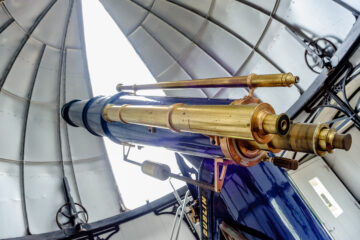RECORD-BREAKING NOVEMBER. SUNNIEST NOVEMBER AT ARMAGH FOR 98 YEARS, WARMEST FOR 11 YEARS, AND WETTEST FOR 4 YEARS. AUTUMN 2022 THE SECOND WARMEST ON RECORD AT ARMAGH, THE THIRD WETTEST AND THE SUNNIEST AT ARMAGH FOR 19 YEARS.
Armagh Observatory, 13th December 2022. Armagh Observatory reports that November 2022 was much sunnier than average, very mild, and much wetter than average. This was the warmest November at Armagh for 11 years and the equal-fourth warmest November at Armagh since daily temperature records began at the Observatory in 1795. It was also the wettest November for four years and the sunniest at Armagh for 98 years. Taking September, October, and November together the meteorological autumn was the second-warmest autumn on record at Armagh, the third wettest, and the sunniest at Armagh for 19 years.
November 2022 increased to a record 18 months at Armagh a remarkable period in which every month after May 2021, albeit with April 2022 only marginally so, has been warmer than that month’s most recent (1991-2020) 30-year average.
In the case of November 2022, the mean monthly temperature, which is defined as the average of each day’s maximum and minimum temperature, was 9.0 degrees Celsius (48.2 Fahrenheit). This was nearly 2.8 C warmer than the 225-year long-term (1796-2020) average November temperature at Armagh (6.22 C) and nearly 1.7 C more than the most recent (1991-2020) 30-year average (7.33 C). This was the warmest November at Armagh for 11 years, that is, since November 2011 (mean temperature 9.4 C) and the equal fourth-warmest November at Armagh since daily temperature records began at Armagh around 1795. The five warmest Novembers at Armagh are now 1994 (9.6 C), 2011 (9.4 C), 1899 (9.3 C) and 2022 and 1997 (both 9.0 C).
It is interesting to note how fast November temperatures have increased at Armagh over the last thirty years or so. For example, the most recent (1991-2020) November average temperature at Armagh is 7.33 C. This is approximately 1.2 C higher than the corresponding (1961-1990) 30-year average (6.12 C) and is the largest such increase at Armagh for any calendar month of the year.
A similar degree of warming is shown by the individual maximum and minimum daily temperatures. This November, the average daily maximum temperature was 12.0 C, approximately 1.7 C warmer than the most recent (1991-2020) 30-year average at Armagh (10.3 C). The average daily minimum temperature was 6.0 C, also approximately 1.7 C warmer than the corresponding most recent 30-year average (4.3 C).
The first fortnight of November 2022 was remarkable not just for being unusually warm, for November, but also for several very warm days and nights. This was the result of a weather pattern eventually being set up dominated by a stream of warm air being carried northwards on south and south-westerly winds originating from the subtropical North Atlantic Ocean. The weather pattern was rather like that which brought a very mild end to 2021 and may be associated with the cyclic weather phenomenon known as the North Atlantic Oscillation.
The warmest day (highest maximum temperature) was 17.6 C on the afternoon of the 11th. This was the warmest November day at Armagh for more than 178 years, that is, since measurements of daily maximum and minimum temperatures began in 1844. The unusually warm day occurred during an exceptionally warm period. For example, the second warmest and third-warmest days were 16.6 C on the afternoon of the 10th and 16.5 C on the 13th. These were respectively the seventh and eighth-warmest November days on record at Armagh.
Considering that the most recent (1991-2020) 30-year average of the daily maximum temperatures for November at Armagh is 10.3 C, it is noteworthy that for the first 16 days of the month each daily maximum temperature exceeded this average. Furthermore, with just one exception (the 4th), each day of the first fortnight (1st to 14th) of November exceeded this 10.3 C average by at least 2 degrees Celsius. There were even two short spells (the 5th to the 7th and the 9th to the 13th) when each day’s maximum temperature exceeded the most recent 30-year daily maximum average by more than 3 degrees C, suggesting a November heatwave.
The warmest night (highest minimum temperature) was also exceptionally mild (14.3 C), a value recorded on the 11th although it occurred shortly after 09:00 GMT on the 10th. As with the warmest day, this was the largest daily minimum November temperature ever recorded at Armagh, that is, in a series of daily minimum temperatures beginning in 1844. The second largest minimum temperature, namely 12.3 C, was attributed to the 13th but occurred during the early evening of the 12th.
The coldest day (lowest maximum temperature) was 7.2 C on the 17th followed by 7.8 C on the 19th. The coldest night (lowest minimum temperature) was just 0.5 C on the morning of the 19th, followed shortly thereafter by 1.2 C attributed to the 20th.
There were 12 ground frosts this month, the coldest three of which were -6.2 C on the 19th, -4.6 C on the 4th, and -2.7 C on the 17th. Unusually, there were no nights this month with air frost (minimum air temperature less than or equal to zero Celsius).
As with November 2021, grass continued to grow, lawns needed to be cut, and leaves remained on trees right up to the end of the month. This November was also relatively calm with no named storms, as indeed were both September and October. This made autumn 2022 the first autumn in the UK and Ireland with no named storms since the official naming of storms was introduced in 2015. On a more seasonal note, five geese were seen flying east over the Observatory around the time of observations on the 14th.
Total November precipitation was 92.8 mm (3.65 inches) including 4 trace values, therefore 92.6 mm if trace values are ignored. This is approximately 25% more than the 183-year long-term (1838-2020) average November precipitation at Armagh and 13% more than the most recent (1991-2020) 30-year average. The wettest day was the 21st with 20.8 mm (0.82 inches) of rainfall followed by the 2nd with 17.8 mm and the 20th with 11.6 mm. This was the wettest November at Armagh for four years, that is, since November 2018 (109.8 mm).
The month was also exceptionally sunny. The sunniest day was the 3rd with 7.9 hours of strong sunshine, followed by the 16th with 7.5 hours and the 15th with 6.2 hours. The monthly total of 89.8 hours of strong sunshine was approximately 51% more than the 140-year long-term (1881-2020) average November sunshine at Armagh (59.5 hours) and nearly 46% more than the most recent (1991-2020) 30-year average (61.6 hours). This was the sunniest November at Armagh for 98 years, that is, since November 1925 (89.9 hours of strong sunshine), and the fourth sunniest November on record. The five sunniest Novembers at Armagh are now 1909 (94.5 hours), 1918 (93.5 hours), 1925 (89.9 hours), 2022 (89.8 hours), and 2003 (89.0 hours).
Taking the three meteorological autumn months together, that is, September, October and November, this was the second-warmest autumn on record at Armagh, the third wettest, and the sunniest for 19 years.
The average autumn temperature was 11.7 C (53.1 F), which is almost as warm as the record-breaking autumn 2021 (average temperature 11.9 C), and 1.3 C warmer than the most recent (1991-2020) 30-year autumn average at Armagh. A sign of the strong autumn warming which has occurred in the last decade or two is that the five warmest autumns at Armagh have all occurred in the last 15 years. Furthermore, with each month since May 2021 warmer than average, it seems likely that the year 2022 will be one of the warmest years on record at Armagh.
With each of the meteorological autumn months also wetter than average at Armagh, autumn 2022 was bound to be wetter than average. With a total autumn precipitation of 352.6 mm including 10 trace values this was the wettest autumn at Armagh for 11 years, that is, since the very wet autumn 2011 (365.3 mm). It was also nearly 60% wetter than the 183-year long-term (1838-2020) average autumn precipitation at Armagh (223.2 mm) and 55% wetter than the most recent (1991-2020) 30-year average (227.9 mm). This was the third-wettest autumn at Armagh since daily rainfall records began in 1838.
With September 2022 and November 2022 both much sunnier than average at Armagh, and with October 2022 having about average sunshine, the meteorological autumn was much sunnier than average, with a total of 309.4 hours of strong sunshine. This is nearly 20% more than the 140-year long-term (1881-2020) average number of hours of strong sunshine at Armagh (258.8 hours) and slightly more than 15% more than the most recent (1991-2020) 30-year average. This was the sunniest autumn at Armagh since 2003 (310.1 hours of strong sunshine), and the eighth-sunniest autumn at Armagh since daily sunshine records began around 1880
These data refer to observations at Armagh Observatory, which has been recording the weather at Armagh since 1795.
For further information, please contact:
Professor Mark E. Bailey
Emeritus Director of Armagh Observatory
Armagh Observatory and Planetarium
College Hill
Armagh
BT61 9DG
Tel: 028-3752-2928
E-mail: mark.bailey@armagh.ac.uk



0 Comments